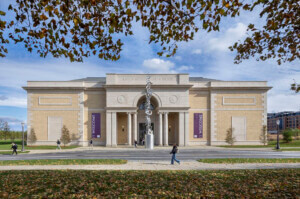Just like it did following the circulation of a leaked draft in early February of this year, the American Institute of Architects (AIA) has released a strong denunciation of a new executive order—finalized and signed within the final 30 days of the Trump administration—that falls short of outright prohibiting modern architecture in the design of new federal buildings but decrees that “classical architecture shall be the preferred and default architecture for federal public buildings absent exceptional factors necessitating another kind of architecture.”
In its rejection of the executive order, the AIA also vowed to work with the administration of incoming President-elect Joe Biden to reverse it.
The last-ditch December 18 order praises the aesthetic and functional merits of “traditional” architecture—interchangeably referred to as “beautiful” architecture—while lambasting federal buildings from the early 1960s and on that have been designed in more contemporary styles. The text refers to modern federal buildings as “ugly,” inconsistent,” “discordant,” and only “sometimes” appealing to the “architectural elite.” Thom Mayne’s Federal Building in San Francisco, the Thomas Phifer-designed Orrin G. Hatch United States Courthouse in Salt Lake City, and Orlando’s George C. Young U.S. Courthouse and Federal Building Annex are all singled out as being displeasing to the current administration.
Reads the AIA’s statement in full:
“The American Institute of Architects (AIA) unequivocally opposes the executive order, ‘Promoting Beautiful Federal Civic Architecture,’ signed by President Trump.
The executive order dictates an architectural style preference for federal courthouses and certain other federal buildings to be mandated by government agencies. The order attempts to promote ‘classical’ and ‘traditional’ architecture above other design styles. The order also incorrectly vilifies the General Service Administration’s (GSA) Design Excellence Program.
‘Communities should have the right and responsibility to decide for themselves what architectural design best fits their needs, and we look forward to working with President-Elect Biden to ensure that,’ said EVP/Chief Executive Officer Robert Ivy, FAIA. ‘Though we are appalled with the administration’s decision to move forward with the design mandate, we are happy the order isn’t as far reaching as previously thought.’
The AIA does not, and never will, prioritize any type of architectural design over another. In February, AIA members sent over 11,000 letters to the White House condemning the mandated designation of ‘classical’ architecture as the preferred style of all federal courthouses, all federal public buildings in the Capital region, and all other federal public buildings whose cost exceeds $50 million.
Communities should continue to have the right and responsibility to decide for themselves what architectural design best fits their needs. The executive order requires extensive justification to use anything other than the preferred design style. While the executive order makes mention of incorporating regional design traditions, in practice it would still cut local voices out of a critical part of the design process. It inappropriately elevates the design tastes of a few federal appointees over the communities in which the buildings will be placed.
The AIA will continue to support The Design Excellence Program, which maintains a style-neutral approach that focuses on community-centered decision-making, demonstrated architectural skill, and public input. The diversity of American architectural achievement is a national treasure that must be continued.
As in February, architecture and design organizations have been quick to rally behind the AIA. Some—and likely many more—have also issued their own statements of rejection to the Trump administration’s dismissal of non-classical architecture styles. This includes the American Society of Landscape Architects (ASLA), whose CEO, Torey Carter-Conneen, issued a brief statement urging the Biden administration to “rescind this order upon assuming office.”
“Civic spaces, whether they be federal buildings, parks, or national monuments, should reflect the values of equality, diversity, and inclusion to which we as a nation aspire. Designers of these spaces should not be mandated by federal law to follow any specific style,” said Carter-Conneen.
Naturally, Architecture Twitter (particularly Brutalist Twitter) has also been quick to react to news of the order, which has been re-titled from “Make Federal Buildings Beautiful Again” to “Promoting Beautiful Federal Civic Architecture.”
“President George Washington and Secretary of State Thomas Jefferson consciously modeled the most important buildings in Washington, D.C., on the classical architecture of ancient Athens and Rome,” reads the order. “They sought to use classical architecture to visually connect our contemporary Republic with the antecedents of democracy in classical antiquity, reminding citizens not only of their rights but also their responsibilities in maintaining and perpetuating its institutions.”
Per the order, “classical” architectural styles include Greek Revival, Art Deco, Beaux-Arts, Georgian, Federal, and Neoclassical. The order also calls for the establishment of a so-called Council for Improving Federal Civic Architecture, which would be composed of all members of the powerful U.S. Commission of Fine Arts, leaders from the General Services Administration (GSA), and up to 20 other individuals from outside the sphere of the federal government, all of them appointed by the Trump administration. The council, which will serve until Sept. 30, 2021, is expected to issue a report with recommended updates to the GSA’S existing architectural guidelines.
The executive order, in both of its versions, largely mirrors the views of the Washington, D.C.-based nonprofit National Civic Art Society. In a statement released yesterday, the group’s president, Justin Shubow (also a Trump-appointed member of the U.S. Commission of Fine Arts) applauded Trump for signing the executive order and decried the “Modernist mandarins controlling government architecture” who he believes have been “forcing ugly designs upon us” since the mid-20th century.











